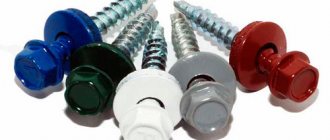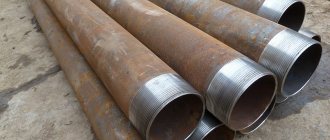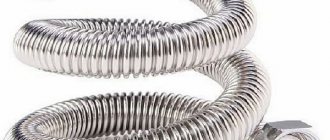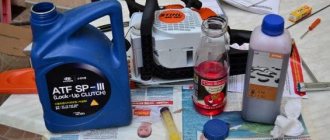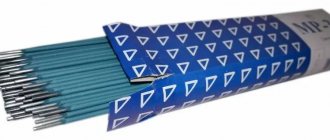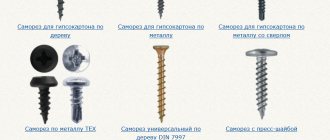Today, various types of colored coatings are in great demand for roof finishing: ondulin, soft and metal tiles, corrugated sheets. For their installation, manufacturers offer a choice of specialized fasteners. Let's look at what a roofing screw is: sizes, types. Let's get acquainted with the advantages of modern hardware against the background of the once traditional slate nails.
Galvanized roofing screws with drill Source roofing.ru
Types of roofing screws
There are several technical characteristics of roofing screws by which they are usually classified.
- According to the shape of the head: there are hexagonal self-tapping screws, the head of which is immersed in the surface; and round with a thread for a screwdriver.
- By function: for fastening the sheathing to the rafters, for fixing the roof to the sheathing, etc.
- According to the material from which the screws are made: self-tapping screws are made of stainless or carbon steel.
- In size: the sizes of self-tapping screws for roofing vary from 16 to 150 millimeters in length, and in diameter these products can be 4.8, 5.5, 6.3 millimeters.
- According to the material for fixing: there are self-tapping screws for fastening to metal or wooden bases.
How to screw a self-tapping screw into thick metal?
It is quite possible to screw any roofing screw or galvanized one with a press washer into thick metal, even if the hardware is not equipped with a drill. To do this, you just need to pre-drill the base. Using this method, you can tighten screws even into metal thicker than 5 mm.
The main principle for such operations is that the diameter of the drill should differ from the diameter of the screw by only a few tenths of a millimeter. The thicker the base and the harder the metal, the smaller the difference. For example: for tightening galvanized products 4.2 mm. in metal 2 mm. You will need a drill of 3.5 - 3.8 mm, and for screwing into metal 5 mm. You will need a 4.0mm drill. To achieve this goal, it is worth purchasing several drills, in increments of 0.1 mm, up to the stated diameter of the self-tapping screw.
Before screwing it into a critical place, it is better to drill a test hole and try to tighten the screw. After all, if the diameter is poorly chosen, the cap will easily break off and it will be difficult to remove the stuck tip.
Functions of self-tapping screws
Self-tapping screws are intended for reliable fastening of structural parts and products to each other. At the same time, their design makes the installation process simple and convenient.
The tip of a self-tapping screw, made in the form of a drill, allows you to penetrate the material without much effort and without damaging the products, without performing preliminary drilling. The presence of a continuous thread guarantees high-quality and reliable fixation. The head for the roofing screw is made in such a way as to ensure maximum ease of tightening with a screwdriver or wrench.
Another advantage is the presence of a washer with an elastic gasket, due to which, even when tightened tightly, there is no squeezing or damage to the products. The elastic gasket also makes the connection waterproof, and the structure is not only durable, but also reliably protected from corrosion.
The variety of types and sizes of roofing screws make them suitable for installing various types of roofing products. In particular, self-tapping screws for wood and metal differ significantly from each other both in the shape of the tip and in diameter, as well as in the features of the thread.
Different types of self-tapping screws are used to secure different roofing materials. For example, galvanized self-tapping screws are used to fasten rafters, and self-tapping screws with a press washer are used to install sheathing. Therefore, you must first decide on the type of product, and then calculate the required quantity for the work.
The required length of roofing screws for certain installation work is determined based on the thickness of the products being fastened and the required penetration depth of the screws.
Preparing the sheathing for covering
Before laying it is necessary to make a high-quality sheathing . It is made from wooden planks treated with an antiseptic composition. It prevents rotting due to condensation dripping from the inside of the roof. During installation, it is necessary to correctly determine the distance between the planks ( sheathing pitch ) and the distance between the screws.
Based on SNiP data, the following rules for its calculation are recommended:
- with a profile height of 35 mm (HC35) and an inclination angle of up to 15º - up to 0.5 m, more than 15º - 1 m;
- with a profile height of 60 mm (H60) and an inclination angle of 8º – no more than 3 m;
- with a profile height of 70 mm (H75) and an inclination angle of 8º – no more than 4 m;
NOTE!
There must be a ventilation gap between the sheathing and the waterproofing . To create it, a counter-lattice is installed from rafter strips or metal purlins attached along the rafters.
Choice
Once all the necessary characteristics have been determined - diameter, length, color of screws, etc., all that remains is to choose high-quality products for reliable installation.
The quality of self-tapping screws can be determined using the following criteria:
- Well-known manufacturers put a stamp on the cap of the product; Accordingly, in its absence, you can be wary of counterfeits made from low-quality steel.
- The thickness of the galvanized layer is indicated on the packaging (normally more than 12 microns).
- The washer must have a tightly attached gasket at least 2 millimeters thick. When compressing the washer with pliers, the gasket should not deteriorate or peel off.
- If there is a color color on the surface of the self-tapping screw, it should also not be damaged by control bending with pliers.
To guarantee the purchase of high-quality self-tapping screws, we can recommend branded European products. Of course, such products will cost more in price, but the high quality of the manufacturing material, the reliability and durability of the product, along with a long-term warranty from the manufacturer, will serve as sufficient compensation for the costs incurred.
Standard sizes, length
In accordance with GOST standards, the diameter of roofing screws for wood is 4.8 millimeters. Their length can be different and be 29, 35, 38, 50, 60, 65, 70, 80 millimeters. Self-tapping screws longer than 60 millimeters are used in cases where it is necessary to attach wavy material (for example, slate) to the tree in the area of the wave crest.
The diameters of roofing screws for metal may vary slightly: 4.8, 5.5, 6.3 millimeters. Products with diameters of 4.8 and 5.5 millimeters correspond to a length of 16-80 millimeters; self-tapping screws with a diameter of 6.3 millimeters - length 19-150 millimeters. Self-tapping screws of short length (up to 29 millimeters) are used for fastening metal products to each other, long lengths (more than 80 millimeters) are used for fixing with multilayer sheathing.
What screws are used to secure corrugated sheeting to the roof?
Self-tapping screws for corrugated roofing are made of high-carbon steel and coated with high-quality galvanization. They are equipped with a special high-strength washer and a plastic gasket (EPDM) , which isolates the edges of the hole from water and contact with the screw head. The screw head itself has a wide hexagonal head with a metric size of M8.
When installing the roof, three types of screws with a diameter of 4.8 mm are used , differing in their purpose:
- for attaching a corrugated sheet profile to a 35 mm long sheathing with a thinner tip in the form of a narrowed drill and a wide thread pitch in the lower flange (sole) of the corrugated sheet;
- for fastening sheets on the top flange of a 20 mm long comb with a wide drill-shaped tip and a fine thread pitch;
- for fastening ridge strips - length from 50 to 80 mm.
Self-tapping screws for roofing
Rules for fastening roof elements
The technological features of the fastening process depend on a number of factors: the type of products used, their thickness, characteristics of the sheathing, etc. However, in all cases, the length of the roofing screw must exceed the total thickness of the products being fastened by at least 3 millimeters.
In most cases, self-tapping screws can be attached to a particular material without pre-drilling. However, in some situations, through drilling may be necessary first, and then the self-tapping screw is screwed in. Most often, this is resorted to when working with thick metal products to avoid damage to the screw tip.
Pre-drilling is carried out using a drill, and the diameter of the drill should be 0.5-1 millimeter smaller than the diameter of the self-tapping screw. When working with thick metal products, some experts recommend making holes in them that are larger than the diameter of the screws. This is done in order to provide the roofing elements with some mobility, which is important in the presence of serious temperature fluctuations.
Various tools can be used for tightening, depending on the type of screw head, for example a wrench, screwdriver, screwdriver, etc.
You should be careful about the force with which the twisting process is performed. It should be sufficient to tightly press the washer with the gasket, but you should not overdo it here - this can lead to damage to the roofing materials.
It is worth briefly mentioning in which specific areas the fastening of certain roofing products is carried out. Corrugated sheeting or metal tiles are attached where there is the greatest contact with the sheathing, that is, at the base of the waves. Slate, on the contrary, is attached to the crest of the wave (for more details: “What types of slate nails are there - sizes, rules for using nails and screws for slate”). If the roof is assembled from small elements and parts, then the fastening is carried out in overlaps hidden from view.
general description
Roofing screws are a group of fasteners that are designed for installing sheet, tile roofing or shingles. Since the material is operated in aggressive environmental conditions and is constantly subjected to mechanical stress, high-grade hydrocarbon steel is used for the production of products. Next, the workpieces undergo a galvanizing process. Stainless steel can also be used. It makes the product cope better with natural phenomena and is more expensive.
Structurally, hardware is represented by three functional “parts”:
- Leg.
This is a rod with an external thread, usually along its entire length. Depending on the pitch between the turns, self-tapping screws are selected for screwing into a wooden or metal sheathing.
- Tip.
There can be a design in two versions: pointed or in the form of a drill. The first is suitable for immersion in soft materials, the second, the so-called self-tapping, is capable of independently passing through a solid base. That is, you do not need to select a drill for the roofing screw.
Examples of different tips for threaded fasteners Source tildacdn.com
- Head.
The outer part of the screws performs several tasks. The main one is the supporting part for the tool, with the help of which the fastener is screwed into a particular object. The second function is secondary - a “plug” for the hole made, which protects the damaged area from leakage and clogging of the hole.
A distinctive feature of roofing screws from other hardware is the washer. Included with the hardware are elastic seals, which have a diameter larger than that of the cap. They must retain their quality characteristics for a long time after repeated exposure to temperature and humidity changes. The main task of these elements is to seal the holes and compensate for the thermal expansion of the fixed roofing deck.
Fasteners with press washer Source 1000melocheysochi.rf
Standardization
The production of roofing screws falls under the control of GOST R ISO 10510 of 2013 (“Self-tapping screws with washers assembled with flat washers”). The requirements regarding the dimensions and technical characteristics of materials are specified here. Here are a few highlighted exceptions to the first criterion:
- the diameter of the leg should allow the washer to rotate freely, but the thread should create an obstacle to its falling out;
- the gap between the first turn and the lower border of the head must exceed the thickness of the sealing gasket;
- towards the tip, the diameter of the rod should be reduced in relation to the main threaded part.
Regarding mechanical properties, the document contains a reference to the requirements according to GOST R ISO 2702 of 2009. Here we are talking about self-tapping screws, which were subjected to heat treatment during the manufacturing process. This procedure is also carried out for roofing screws.
Calculation of the required number of screws
The number of screws per square meter required for fastening a particular material is usually indicated in the instructions for the roofing products themselves. Often, along with this, a diagram of their location is also described. The instructions for use usually indicate other nuances, for example, the need to use different types of screws, etc.
Most often, per square meter of metal tile products requires 2-3 short screws for metal and 3-4 medium screws for wood. As for the additional elements, about ten long self-tapping screws are required per meter of their length.
If a slate covering is being installed, then each sheet of the product requires an average of 2 to 4 wood screws.
Of course, the above figures are approximate and averaged, and for more specific calculations you need to have a detailed roof arrangement diagram on hand.
Roofing pie device
The roofing pie consists of the following layers:
- rafters directed from the ridge to the eaves;
- waterproofing material;
- ventilation gap;
- sheathing;
- corrugated sheets.
Roofing pie
Features of using self-tapping screws for wooden roof structures
For the purpose of fastening roofing elements to a wooden base, several types of fasteners are usually used:
- To install the sheathing, use roofing screws with a press washer.
- For rafters - simple galvanized nails and screws.
- Directly for the roof itself - wood screws.
Features of roofing wood screws are their small diameter and sparse carving. They are optimally suited for attaching all kinds of roofing elements to a wooden base.
How to calculate the required number of hardware?
Since self-tapping screws ensure reliable fastening of the roofing material, it is important to correctly calculate the consumption of hardware to complete the task. Experts have calculated that for one product measuring 1 square meter you will need about 10 hardware. This is suitable for the installation of standard size materials. If you need to install dimensional material of complex configuration, the consumption will increase.
The required amount of hardware depends on the following indicators:
- thickness and weight of roofing material;
- roof surface area;
- roofing material configuration.
Self-tapping screws for metal structures
To fasten roofing materials to a metal base, metal roofing screws are used, as well as self-tapping screws with a press washer and a drill.
Self-tapping screws for metal, in comparison with the corresponding wood products, are somewhat shorter in length in the case of the same diameters. The threads on them are located more often. The tip is made in the form of a special metal drill, which allows you to easily screw them into metal products. In particular, they can easily drill 1 mm metal base and 5 mm metal roofing products.
Usage
These products are mainly used for joining wooden or metal structures. Moreover, the use of self-tapping screws for each such material has its own characteristics.
Tree
Wooden material has its own specifics for connecting self-tapping screws. This explains the use of the following types of fasteners:
- Self-tapping screws with gasket. Connect wooden bases to a lattice structure;
- Galvanized roofing screws are used for the load-bearing system of a pitched roof;
- Standard screws. Used for installation of the roof itself.
Metal
This material has its own nuances regarding fastening. The following type of fasteners is used to connect materials:
- Roofing products for metal. They have a short length. They are special with frequently located carvings on their product. Easily copes with penetration into metal;
- Hardware equipped with a press washer and drill. Such self-tapping screws can be colored (have heads of different shades) and can be used for roofs of different colors.
The peculiarity of the products is that they can penetrate the material by both 1 mm and 5 mm.
Features of roofing screws with a press washer
Roofing self-tapping screws with a press washer are designed for screwing roofing materials to the base as tightly as possible. Their hat is shaped like a hemisphere with a cross-shaped cut in the middle for twisting. The diameter of these fasteners is always the same - 4.2 millimeters, while the length ranges from 13-76 millimeters.
It should be noted that this type of screws is not recommended for use in direct contact with water.
Self-tapping screws with a press washer come in two types:
- galvanized sharp - designed for fixing roofing elements to a wooden base, the threads on them are deep and sparse;
- with a drill - their drill-shaped tip is designed for drilling and screwing into a metal base or other products; the thread is superficial and dense.
How to make a roof with your own hands: tips
Since the issue of erecting roofs yourself is quite relevant, it is important to outline what rules to follow so that in a couple of years your roof does not start leaking. Most often, self-tapping screws with a hex head, gaskets and a metal or rubber washer under the head are used to attach roofing sheets to frames.
When the fastener is installed, it is pressed against the metal roofing to form a watertight seal. If the screws are screwed in correctly, this should essentially prevent the roof from leaking and deforming the sheets.
If you decide to install the roof yourself, take note of a few simple tips:
- make sure that you choose the right self-tapping screw - the right length and from the right material, depending on the operating conditions and existing risks;
- Pay attention to the instructions for the roofing material. Roofing manufacturers often recommend specific fasteners and fastening patterns for their products depending on the roof's structural material;
- self-tapping screws must be driven into the metal roof perpendicular to the plane of the roof so that the washer evenly fits into the mounting hole;
- It is better to screw in self-tapping screws, controlling the application of force to avoid overload. Otherwise, excessive clamping may lead to deformation of the screw or the roof profile itself. Therefore, a self-tapping screw will not create an effective seal.
Choosing between self-tapping screws and slate nails
Before the advent of self-tapping screws, fastening roof elements to each other was carried out using simpler and cheaper products, the main ones of which were slate nails. A distinctive feature of such nails is that they are galvanized and equipped with a wide washer. In addition to this, when driving them, a rubber gasket is often also used to provide waterproofing.
Connecting roofing products using slate nails is less durable than using self-tapping screws, and the steel material from which they are made is of lower quality. Such nails cannot be used for fastening metal products, and when working with other materials they require preliminary drilling. When driving nails, there is a fairly high risk of damage to products.
Working with self-tapping screws is much simpler and more convenient. It is also important that the self-tapping screws produced have a large number of colors and designs. This allows you to choose the best option for a roofing covering of any color, making it invisible against the general background.
In cases where the priority is the economy of the structure, and you need to equip a cheap roof with a service life of 10-15 years, you can choose slate nails. If the reliability of the structure being built, with a long service life of several decades, comes first, then the use of modern high-quality materials and fastening products, which include roofing screws, is mandatory.




